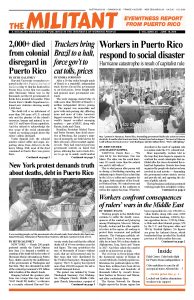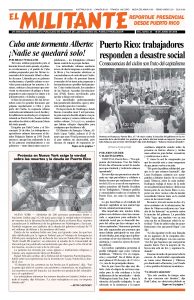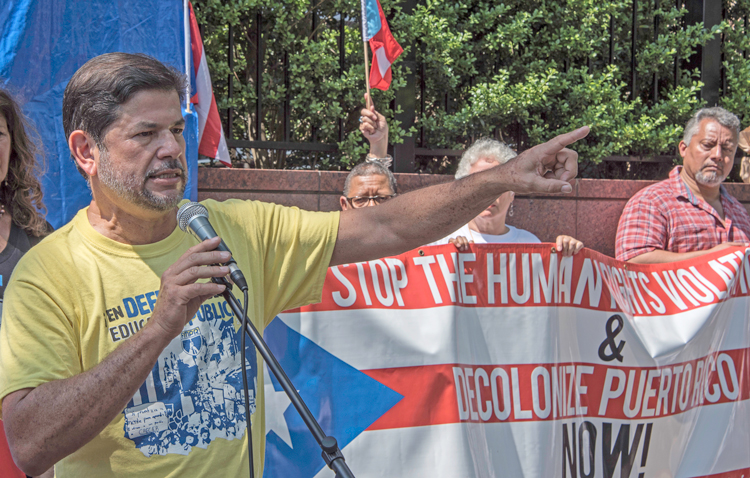NEW YORK — Nearly 200 people protested outside the United Nations here June 2 to demand a truthful accounting of the death toll in the wake of Hurricane Maria’s devastation in Puerto Rico, deaths caused by the indifference of the governments in Washington and San Juan. They also demanded an audit of the colonial government’s $74 billion debt to holders of the island’s bonds.
Hanging behind the speakers platform was a large blue tarp that read “4645 #audit PR deaths,” a reference to a recently released Harvard University study that said that the official death toll of 64 was nowhere near the real figure. The tarp symbolizes the tens of thousands of homes without roofs, that are still protected only by blue tarps that were distributed by the Federal Emergency Management Agency. The U.S. agency has rejected more than 300,000 requests for aid to rebuild damaged homes.
The protest was initiated by Union Theological Seminary; Fort Washington Collegiate Church; Middle Collegiate Church; Intersections, a project of the Collegiate churches; and Uprose, a long-time Latino organization in Brooklyn.
Rafael Feliciano, organization secretary of the Federation of Puerto Rican Teachers, told the crowd about his experiences after the storm in Cayey, Puerto Rico, where he lives.
“The clearing of the roads was not done by the government,” he said. “It was the people who opened the road with machetes and chainsaws, not the government. The deaths aren’t from the hurricane. The deaths are the product of colonialism and capitalism.”
Feliciano said that teachers organized with parents and others in their local communities to clean up and restore the schools, even though “the Department of Education threatened them,” claiming they would get more funding if the schools were left damaged.
“We protested, we forced them to reopen more than 90 percent of the schools,” he said.
Working people face the same challenges in the U.S. and around the world, Feliciano said. “The working class is one, no matter where it is.”
The same day, hundreds of Puerto Ricans took part in creating a powerful memorial to those who died as a result of the hurricane, placing their shoes outside the U.S. colony’s Capitol. Over hours, more than 1,600 pairs of shoes were placed in the square, many accompanied by notes, flowers and Puerto Rican flags.
Word of the memorial spread over social media, and people came from all over the island. “The deaths are the responsibility of a government that does not respond and of another government that supposedly is supportive but what it is really doing is destroying,” professor Luisa Márquez told Primera Hora, referring to the governments of both Puerto Rico and the U.S.
Cristina Vázquez’s father died in the wake of the storm. “We don’t know the details because we came to his house and found him dead,” she said. The coroner told them “that he had to put down it was because of ‘natural causes.’”
Others who spoke at the New York action included Elizabeth Yeampierre, executive director of Uprose; Judith Sheridan-González, president of the New York State Nurses Association; Alejandro Molina, a key organizer of the fight to free Puerto Rican independence fighter Oscar López, who won release last May after more than 35 years in U.S. prisons; and several members of New York’s Puerto Rican community.


